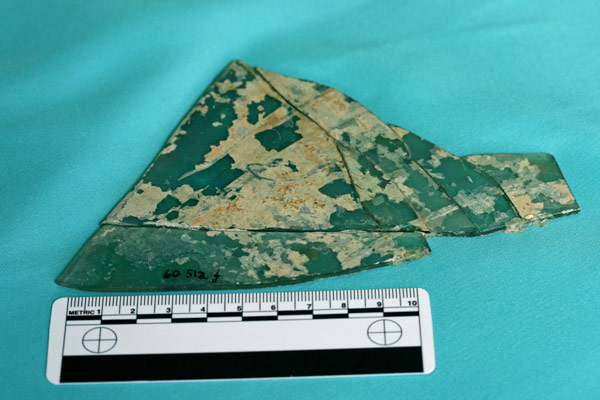This glass window pane was found in the bath house excavations by Michael Green, Roman Glass 1959 and is one of many pieces of window glass found all over Godmanchester. The bath house which is on Pinfold Lane dates from the early second century and excavations show that it was constructed to a sophisticated level of service for the local inhabitants and indeed for the many travellers passing through the town.
Roman Glass 1959 and is one of many pieces of window glass found all over Godmanchester. The bath house which is on Pinfold Lane dates from the early second century and excavations show that it was constructed to a sophisticated level of service for the local inhabitants and indeed for the many travellers passing through the town.
It's worth remembering that a Roman bath house was more than a place to bathe in, but somewhere to socialise. You would expect there to be local traders selling food within its walls, certainly trays of bead rolls and cakes or biscuits sweetened with honey and perhaps even savouries - Roman soldiers were particularly fond of sausages and meat pies as indeed were the rest of the population. Very likely scented oils were also commercially available to bathers using the natural perfumes from plants grown locally such as lavender, roses and rosemary and some expensive perfumes imported and brought by mule train up Ermine Street, the main trading route between London and Hadrian's Wall.
The Roman town of Godmanchester, identified as Durovigutum, did not exist in isolation. Its creation was a result of the decision to invade Britain made a thousand miles away in Rome. Although we have no written accounts of the town's history in the Roman period, we can see the history in the archaeological record, and that events in Roman Britain and the wider Empire continued to affect the people
THE FIRST CENTURY AD
43AD Emperor Claudius invaded Britain. The fight against Rome was led by the rulers of the powerful south-eastern Catuvellauni tribe. The previous ruler, Cunobeline (Shakespeare's Cymbeline) enjoyed good relations with Rome, which heightened his wealth and power, displayed by the gold coins he minted from his capital at Camulodinum (Colchester). His sons, Caratacus and Togodumnus were defeated, Togodumnus died and Caratacus fled west to continue to fight Rome for the next nine years. Catuvellauni territory was rapidly subdued, in part by the construction of a series of forts.
One of these forts was built near a ford in the river Great Ouse to control the river crossing. There were already homesteads here, round houses of the local Catuvellauni people. The civilian settlement, or vicus, that grew up around the fort became the Roman town of Durovigutum, and later, Godmanchester. Remains of the early vicus have been found in Post Street and at Park Lane. With the south-east conquered, fighting moved out of the region, and the first fort here was dismantled before the ditches were completed.